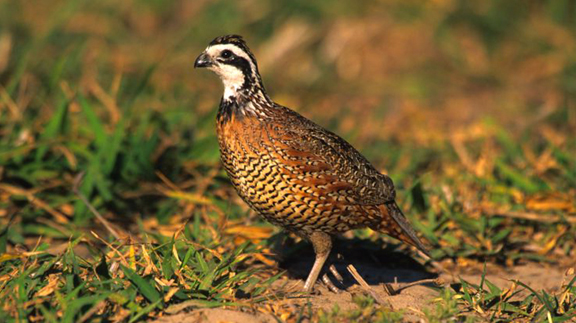Farm & Ranch
National Ranching Heritage Center Hosts Inaugural Quailapalooza

DATE: March 30, 2015
CONTACT: Sue Jones, [email protected]
(806) 834-2646
National Ranching Heritage Center Hosts Inaugural Quailapalooza
With the quail being an important part of the South Plains ecosystem, children will have the opportunity to learn more about this bird.
Children 6-12 years old will have a hands-on opportunity to see how scientists study quail during the inaugural Quailapalooza from 1-3:30 p.m. April 18 at the National Ranching Heritage Center (NRHC) at Texas Tech University.
“For many ranchers, the northern bobwhite quail is a treasured rangeland inhabitant,” said Brad Dabbert, a Texas Tech University professor of natural resources management who will share his knowledge with some of the area’s youngest students. “Unfortunately, bobwhite populations are declining throughout their historic range in Texas.”
The NRHC will partner with the Department of Natural Resources Management at Texas Tech to host a hands-on educational presentation for children focusing on Northern Bobwhite Quail and the science behind studying this ecology.
Dabbert and Texas Tech graduate students will give participants the opportunity to see live adult quail and chicks, learn about thermal cameras and radiotelemetry, observe a quail nest and eggs, learn what quail eat and how scientists capture them, and see how scientists use cameras to study bobwhites and quail predators.
The program is free to NRHC Junior Roughriders and $5 for non-members. Limited space is available. To register for the event, contact NRHC Director of Educational Programs Julie Hodges at (806) 742-0498 or [email protected].
Supported by the Ranching Heritage Association and Texas Tech, the NRHC is a unique 27-acre museum and historical park offering educational programs and exhibits to promote interest in ranching history and contemporary ranching issues. Located at 3121 4th St., the center provides 49 authentic dwellings and ranch structures from some of the nation’s most historic ranches.
Find Texas Tech news, experts and story ideas at Texas Tech Today Media Resources or follow us on Twitter.
CONTACT: Julie Hodges, director of education programs, National Ranching Heritage Center, Texas Tech University, (806) 742-0498 or [email protected]
Farm & Ranch
Hazards of Backyard Poultry

By Barry Whitworth, DVM
Having backyard poultry is a popular agriculture enterprise. According to the United States Department of Agriculture, 0.8 percent of all households in the United States have chickens. People keep chickens for a variety of reasons with table eggs being one of the more common reasons.
Unfortunately, some of these poultry producers are not aware of the hazards that come with keeping poultry because many times they carry pathogens but appear healthy.
Chickens are carriers of several zoonotic diseases. These are diseases that can be passed from animals to humans. According to a recent survey in Pennsylvania, a majority of backyard poultry producers were aware of the dangers of avian influenza. However, this study also revealed that far fewer producers were aware of the risk of possible exposure to Salmonella and Campylobacter.
The lack of knowledge about the hazards of raising poultry likely contributes to the continued issues of Salmonella outbreaks associated with backyard poultry. In 2023, the Centers for Disease Control and Prevention reported 1,072 illnesses of Salmonella linked to backyard poultry, and 272 of those patients required hospitalization. Oklahoma reported 43 individuals with the disease.
To read more, pick up a copy of the April issue of NTFR magazine. To subscribe by mail, call 940-872-5922.
Farm & Ranch
Ag Elsewhere: Wyoming

By Tressa Lawrence
Babies are tucked away in every nook and cranny. Many ranchers across Wyoming have baby animals popping up all over this time of year.
Farm & Ranch
Ag Elsewhere: Montana

By Lindsey Monk
Another load of grain in to keep feeding the calves until the green grass can really start popping.
-

 Country Lifestyles1 year ago
Country Lifestyles1 year agoScott & Stacey Schumacher: A Growth Mindset
-

 Equine7 months ago
Equine7 months agoThe Will to Win
-

 Country Lifestyles7 years ago
Country Lifestyles7 years agoStyle Your Profile – What your style cowboy hat says about you and new trends in 2017
-

 Country Lifestyles4 years ago
Country Lifestyles4 years agoAmber Crawford, Breakaway Roper
-

 HOME7 years ago
HOME7 years agoGrazing North Texas – Wilman Lovegrass
-

 Country Lifestyles7 years ago
Country Lifestyles7 years agoDecember 2016 Profile, Rusty Riddle – The Riddle Way
-

 Country Lifestyles8 years ago
Country Lifestyles8 years agoJune 2016 Profile – The man behind the mic: Bob Tallman
-

 Outdoor9 years ago
Outdoor9 years agoButtercup or Primrose?






